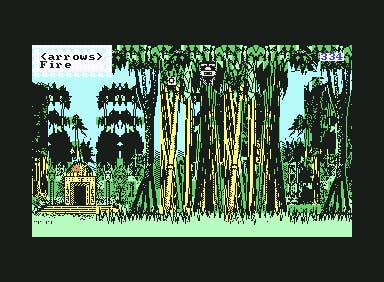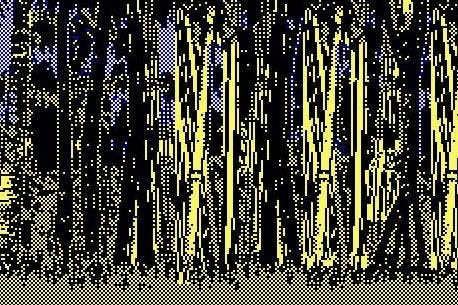The origins of the walking simulator
A step back in time.
If there's a genre of videogames today that diversifies players like no other, it's the walking simulator. Many examples have found favour, especially at Eurogamer, with Firewatch and, latterly, Virginia, both well-received. Yet for every praiseworthy voice, there are critics, keen to expose this style of game for being over-hyped, underwhelming and, frankly, boring.
Like so much else in games, the walking simulator is not a new phenomenon, and its roots can be traced back to the 1980s. In a decade that saw its fair share of innovation, mixed with rampant cloning and bandwagon-jumping, freelance developer (ie bedroom coder) Graham Relf came up with the idea of a purely explorative game, a procedurally-generated terrain and countless locations to visit and search. Explorer had a suitably apt title but, despite its technological achievement, it was met with indifference in the gaming press of the time. However, Explorer's, and its author's, story began 15 or so years earlier.

"Computers were very new when I was at school," begins Relf. "I didn't get near one until I was a physics student at Imperial College. There was a short course in FORTRAN in my second year and I took to it like a duck to water." The year was 1969; code was produced on punched cards which were then submitted into the College's IBM7904 mainframe. There were no terminals on desks, discs, or even cassettes. "We'd get the printed output the next day - if we were lucky - then, of course, it took many attempts to iron out the bugs." Despite this painstaking process, Relf gained employment with an R&D company in 1974, occasionally indulging in the immense luxury of actually being able to input code via a teletype terminal.
Then, in 1978, the first home computers began to appear: "I bought a Tandy/Radio Shack TRS-80 because it had a massive 16 Kbytes of RAM..." On this primitive machine, Relf began to contemplate the idea of a program based upon terrain generation. "Having so little RAM made the idea seem natural to me; to generate terrain from mathematical functions rather than storing them in the memory. The program needed very few bytes to keep track of the player's co-ordinates, so why not calculate what would be at that location?" After an initial effort creating an impressive 3D maze, Relf wrote an article on the subject for Popular Computing Magazine and began working on his next project, this time on his new ZX Spectrum computer.
Many of today's walking simulators involve exploration with a purpose of solving a mystery or puzzle of some type. Relf's idea was to combine one of his hobbies with his technique, thus creating a game based entirely around the concept of simply navigating using a map, and, err, walking about. A walking simulator in its purest form, The Forest boasted 37 square kilometres of varied terrain to explore: towns, lakes, moors and (obviously) wooded areas all required traversing, each type affecting the speed of travel. The purpose was to visit each checkpoint in sequence, using your navigation skills, in the quickest time possible. It was all about the journey. Explains Relf, "The Spectrum increased the available RAM from 16 to 48 kb and the full colour graphics were vastly superior to the Tandy's limited green on black display. I was always fascinated by maps, and with orienteering having arrived in the UK from Scandinavia in the 60s, I joined a club and got heavily involved in map-making for the sport. Making a game based around it seemed a natural progression."

Orienteering simulation The Forest received a commercial release via small-time software house Phipps Associates. It was diverse enough at the time to receive praise for originality; adventure fans were encouraged to check out its considered and map-based gameplay. "I wrote a letter to John Phipps in March 1984 about potential successors," remembers Relf, "but around that time, he stopped trading." Meantime, Phipps's former colleague, Trevor Toms, had co-founded maverick developer RamJam Corporation, along with Max Headroom creator George Stone and, latterly, graphic artist Simon Dunstan. "It was those three who saw the potential uses of my techniques and got me to developing the Explorer idea further."
That concept ran like this: approaching an Earth-like planet, the player's spacecraft malfunctions, crashing into the surface. Scattered all over the forested and seemingly abandoned planet are nine vital pieces that need to be found if the craft is to fly again. With some technological assistance such as a jetpack, echo sounder and signal beacons, the task at hand became easier, but conquering Explorer was no mean feat, especially given that the advertising bragged of a jaw-dropping 40 billion individual locations. With just nine screens holding the key to escape, the odds of completion must have looked daunting to even the most seasoned of gamers.
Technically, Explorer worked along similar lines to The Forest. Apart from the program code, the computer's RAM only stored the player's properties (such as co-ordinates and inventory) along with a number of graphical components that were assembled ready for each location. Unsurprisingly, RamJam were keen to incorporate an element of arcade gameplay into Explorer; the planet was populated by ghost-like creatures with which the player had a supply of primitive arrows to shoot at. Relf himself devised a system where locations were also given a random name. "Just as a function of position can generate height and terrain type," he explains, "it can also generate strings of letters as place names. It was tricky though: it could accidentally produce something offensive." Explorer also employed a teleporter which used these randomly-generated names - a clear precursor to the fast-travel of many games today.

As a freelancer, Relf worked on Explorer from his home in the North East, occasionally popping down to Soho to visit RamJam's offices. "I don't remember how we worked together, except it was amicable. Actually, on looking through my files the other day I found a note containing handwritten instructions for using a modem to communicate so I think Simon must have sent it by that means. Either that or tapes through the post I suppose." Simon Dunstan was responsible for Explorer's graphics and brought his distinctive style to the game. "His work was excellent," says Relf. "It had never occurred to me to make such impressive and realistic shapes by line drawings rather than blocks of colour. I was delighted with his input."
Alas, while the sheer technological achievement of Explorer was impressive, the game moved at a slow pace. This found favour with some; most were disappointed by what they viewed as more tech demo than game. "RamJam write some pretty weird and original programs, and this is their weirdest yet," mused Crash Magazine's Paul Sumner in its review. "Unfortunately, what could have been a good idea has been drowned by a massive play area with little variation." The Commodore 64 magazine, Zzap64! was even more savage, particularly Julian Rignall. "...unbelievably tedious, monotonous, pointless, fruitless and rubbish. If you really want to do some exploring, why not buy a rail or bus ticket?" A pitiful score of just 13% was harsh, even considering Explorer's obvious flaws. "I was a bit disappointed at the time," says Relf carefully when I ask him about the reviews. "But I did get satisfaction from the technical aspect of the game. If I'd been doing it as a full-time job, I'm sure it would have been different."
Explorer was published by Activision's UK arm, Electric Dreams. In charge was the ex-Quicksilva man and industry veteran Rod Cousens, and he gave me his thoughts on what appeared from the outset to be a risky project. "It was an interesting subject matter but never translated well in development. We were always experimental, trying to push boundaries, and be different, because we felt that was our charter in being a games company. Not derivatives or more of the same. Sometimes it resonated, sometimes it didn't, but we tried different things." As some of today's walking simulators are discovering, a concept isn't always enough. As for Explorer's talented coder, Graham Relf soon became occupied by other projects and left games behind.
Ultimately, history will mark Explorer (and to a lesser extent, The Forest) as a failure, regardless of its role as a progenitor of today's walking simulators. The game's ambition was never in doubt: its technical achievement in creating a massive, explorable, free-form world, marked it out considerably against a mass of generic shoot-'em-ups and arcade-style games. So, a failure, yes. But a glorious, ponderous and exhausting 40-billion screen failure.









